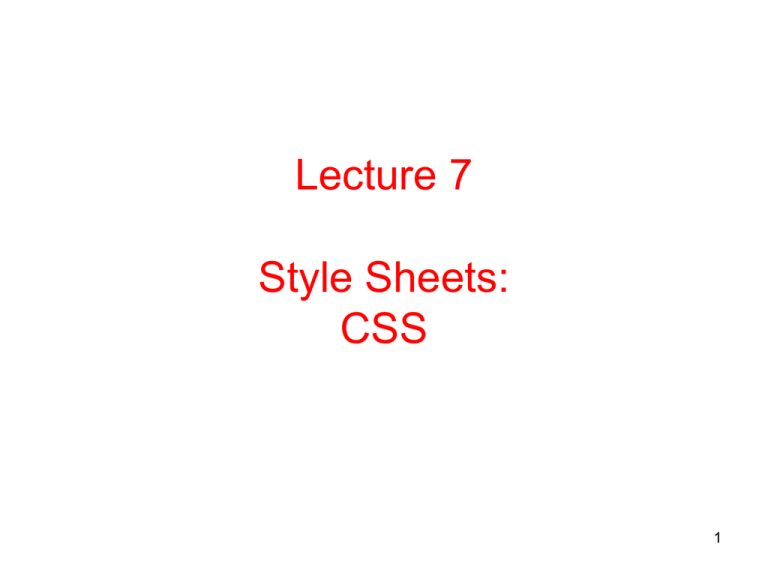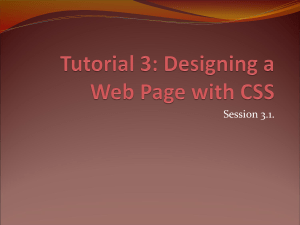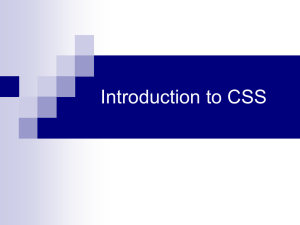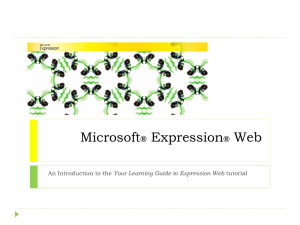Style Sheets: CSS
advertisement

Lecture 7 Style Sheets: CSS 1 Motivation • HTML markup can be used to represent – Semantics: h1 means that an element is a top-level heading – Presentation: h1 elements look a certain way • It’s advisable to separate semantics from presentation because: – It’s easier to present documents on multiple platforms (browser, cell phone, spoken, …) – It’s easier to generate documents with consistent look – Semantic and presentation changes can be made independently of one another (division of labor) – User control of presentation is facilitated 2 Style Sheet Languages • Cascading Style Sheets (CSS) – Applies to (X)HTML as well as XML documents in general – Focus of this chapter • Extensible Style-sheet Language (XSL) – Often used to transform one XML document to another form, but can also add style – XSL Transformations covered in later chapter 3 CSS Introduction • A styled HTML document produced by the style sheet style1.css: 4 CSS Introduction link element associates style sheet with doc. 5 CSS Introduction type attribute specifies style language used 6 CSS Introduction href attribute provides style sheet URL 7 CSS Introduction title attribute provides style sheet name 8 CSS Introduction 9 CSS Introduction Alternative, user selectable style sheets can be specified 10 CSS Introduction • A styled HTML document produced by the style sheet style2.css: 11 CSS Introduction • Single document can be displayed on multiple media platforms by tailoring style sheets: This document will be printed differently than it is displayed. 12 CSS Syntax • Parts of a style rule (or statement) 13 CSS Syntax: Selector Strings • Single element type: • Multiple element types: • All element types: • Specific elements by id: 14 CSS Syntax: Selector Strings • Single element type: type selector • Multiple element types: • All element types: • Specific elements by id: 15 CSS Syntax: Selector Strings • Single element type: • Multiple element types: • All element types: universal selector • Specific elements by id: 16 CSS Syntax: Selector Strings • Single element type: • Multiple element types: • All element types: • Specific elements by id: ID selector 17 CSS Syntax: Selector Strings 18 CSS Syntax: Selector Strings • Elements belonging to a style class: class selector – Referencing a style class in HTML: • Elements of a certain type and class: 19 CSS Syntax: Selector Strings • Elements belonging to a style class: – Referencing a style class in HTML: this span belongs to three style classes • Elements of a certain type and class: 20 CSS Syntax: Selector Strings • Elements belonging to a style class: – Referencing a style class in HTML: • Elements of a certain type and class: this rule applies only to span’s belonging to class special 21 CSS Syntax: Selector Strings • Source anchor elements: pseudo-classes • Element types that are descendents: 22 CSS Syntax: Selector Strings • Source anchor elements: • Element types that are descendants: rule applies to li element that is 23 CSS Syntax: Selector Strings • Source anchor elements: • Element types that are descendants: rule applies to li element that is part of the content of an ol element 24 CSS Syntax: Selector Strings • Source anchor elements: • Element types that are descendants: rule applies to li element that is part of the content of an ol element that is part of the content of a ul element 25 CSS Syntax • Style rules covered thus far follow ruleset syntax • At-rule is a second type of rule URL relative to style sheet URL – Reads style rules from specified URL – Must appear at beginning of style sheet 26 Style Sheets and HTML • Style sheets referenced by link HTML element are called external style sheets • Style sheets can be embedded directly in HTML document using style element • Most HTML elements have style attribute (value is list of style declarations) 27 Style Sheets and HTML • Rules of thumb: – Use external style sheets to define site-wide style – Prefer style sheets (either external or embedded) to style attributes – XML special characters • Must use references in embedded style sheets and style attribute • Must not use references in external style sheets 28 End of Lecture 7 29






